
Shimbaru-Nuyama Mounded Tomb Group
A Group of Tombs Dedicated
to the Munakata Clan,
Who Performed
Rituals on Okinoshima
The Shimbaru-Nuyama Mounded Tomb Group in Fukutsu City comprises the tombs of the Munakata clan, an ancient powerful family that led interactions with overseas countries. The Munakata clan also performed rituals on Okinoshima and nurtured the tradition of faith in the sacred island.
From the fifth to the sixth centuries, the Munakata clan constructed a group of mounded tombs on a plateau, which once overlooked a sea inlet. The plateau commands a view of the marine route toward Okinoshima.
To date, 41 mounded tombs have been well preserved, including five keyhole-shaped tombs with round rear mounds, 35 round burial mounds, and one rectangular burial mound.
Tomb 22 and Tomb 1 were constructed during the fifth century, while Tombs 12, 24 and 30 were created during the early to mid-sixth century; and Tombs 34–43 were built during the latter half of the sixth century.
Tomb 7, constructed in the fifth century on the tip of the terrace surrounded by the sea inlet, is a rectangular mound, which is rare in the Munakata region. The iron adze unearthed from this tomb has features common with those discovered on Okinoshima.
Since the tombs have been well preserved, visitors can stroll among them, viewing round and rectangular mounds and surrounding moats.
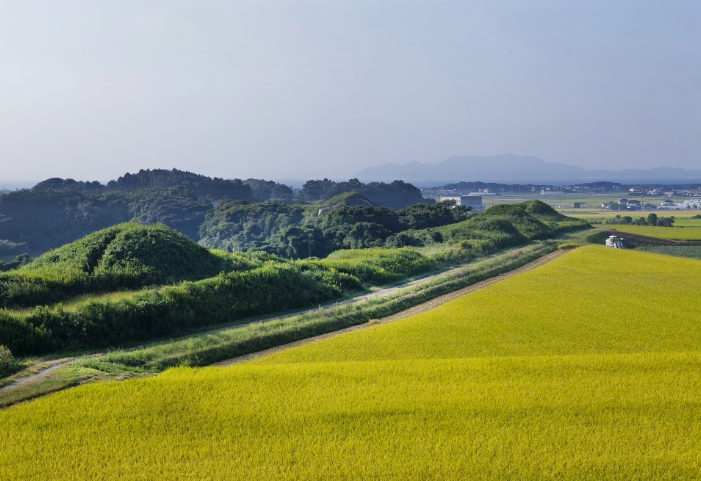
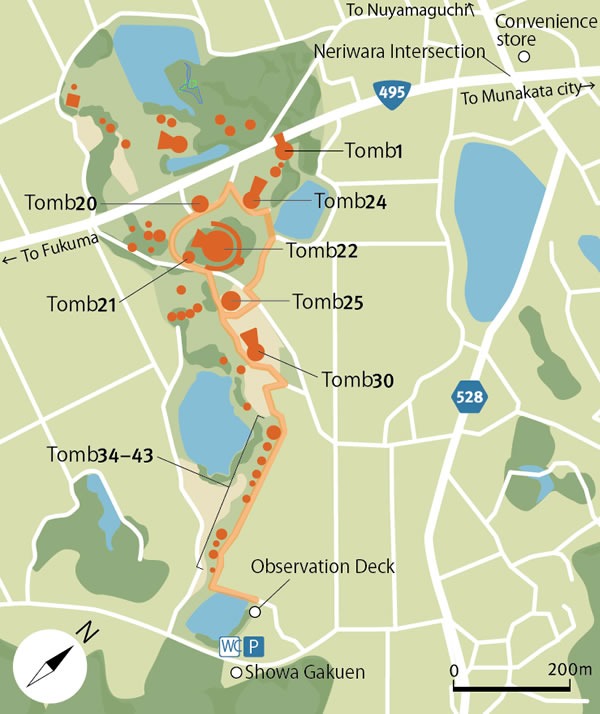
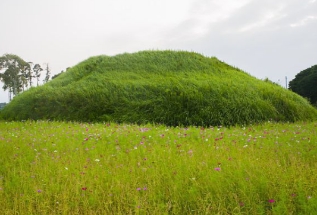
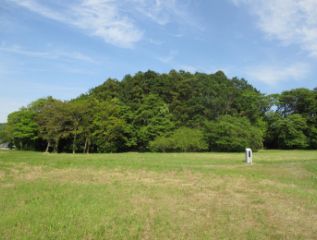
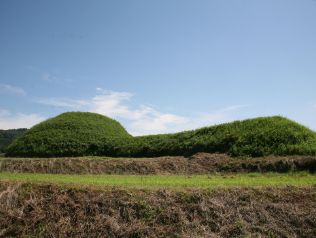
Access
JR Fukuma Station
Nuyama-guchi
Bus Stop
Shimbaru-Nuyama Mounded Tomb Group
Hetsu-miya, Munakata Taisha
Shimbaru-Nuyama Mounded Tomb Group
The mounded tomb group and the sea inlet
Around the time that the Shimbaru-Nuyama Mounded Tomb Group was built, the Katsuura Lagoon served as a natural harbor for the region, a traffic hub connecting inland areas to the sea.
During the Edo period, pine trees were planted so that the stand of trees would serve as an effective windbreak and sandbreak. The sea inlet was reclaimed by means of drainage, part became a salt flat, and part was newly developed as rice fields.
The rural landscape today has been built up by generations of local farm families working and maintaining the land year after year, with local residents cutting the grass and performing other maintenance work.
When the former sea inlet stopped functioning as one, its appearance changed to that of a rice paddy; but the rural landscape that spreads out like a great ocean calls to mind the landscape in ancient times, when ships often passed through this area.
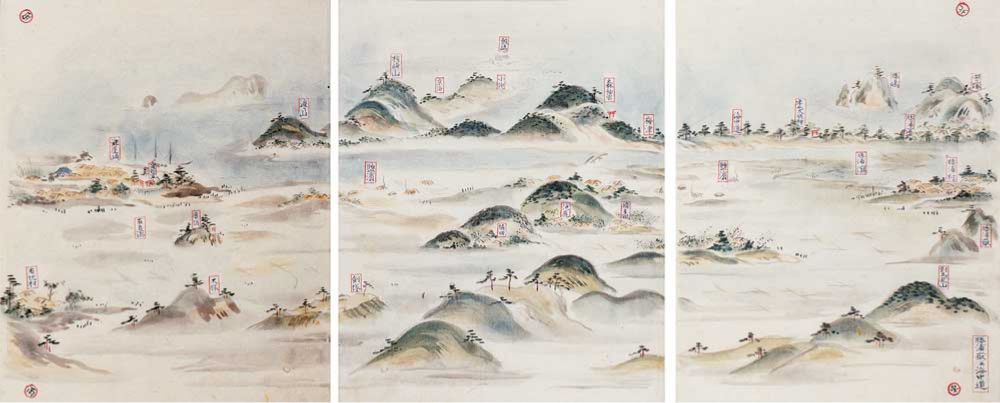
Katsuura-dake narabini Uminaka-michi, in Chikuzen-no-kuni zoku fudoki furoku 1797, private collection.
Edo-period landscape with Katsuura Lagoon. A picturesque landscape of a "sea path" of coastal sandbanks leading into pine groves. On the reclaimed land, smoke rises from cooking by means of salt broiling, and sailing ships gather in Tsuyazaki Harbor, which is connected to the open sea. There are some place names derived from burial mounds, such as "Otsuka" and "Tsurugizuka" on hills as well as farm villages with traditional houses with thatched roofs.
Preserving local mounded tombs for future generations
There are two reasons that the mounded tomb group and its surrounding landscape are well preserved.
The first of these factors is rumors. Local people will say things like "Someone got close to one of the tombs and he ran a high fever for a month," or they will say that the "tomb wind" will make you sick.
These statements reflect a fear of the unknown, and may also have to do with our predecessors' warnings not to infringe upon carefully preserved sacred areas.
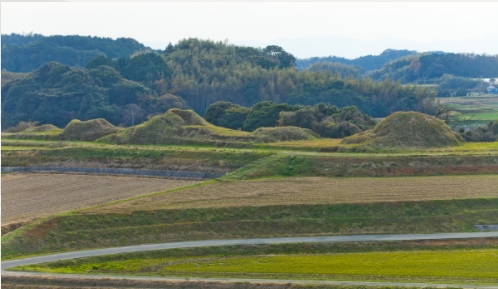
The other reason is the efforts of the local people. People who live in the Nuyama district cannot help but love the local landscape with its mounded tombs.
Each person has his or her favorite view of the tombs. One may say the best view is from the top of that mountain, while another says that sunset is the most beautiful from this or that spot.
Local people periodically mow the grass so that the actual form of each tomb is visible. In addition, there have been initiatives to plant cosmos on the surrounding unused farmland and to convene other events that help people to feel a sense of belonging and ownership toward the mounded tombs.
Historic Sites
Camellia Stage Historical Museum
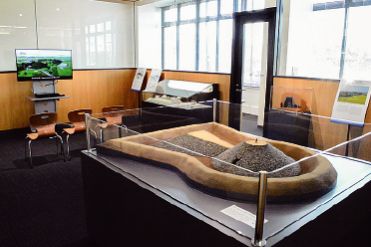
In addition to the Shimbaru-Nuyama Mounded Tomb Group, artifacts associated with the ancient Munakata clan that have been excavated from the tombs in Fukutsu City are also on display.
1-7-2 Tsuyazaki, Fukutsu City, Fukuoka
Tel: 0940-72-1207
Hours: 10:00-20:00
Closed Tuesdays (when Tuesday is a holiday, closed the following working day), the last Wednesday of each month, and New Year’s holiday
Admission: Free
Hyakuto Itabi (lit."One Hundred Stone Monuments") in Shimbaru
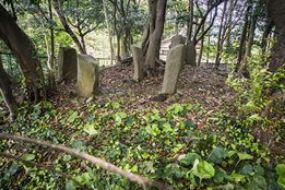
Atop Tomb 21 stand more than a dozen stone monuments with engravings of Buddha images and Sanskrit inscriptions. According to legend, they were erected to console the spirits of warriors killed during the Mongol invasions (in 1274 and 1281). It is likely, however, that a Buddhist monk relocated various older tombstones to this site.
※Contact us: Fukutsu City Board of Education (See below)
Katsuura Inoura Tomb and Katsuura Minenohata Tomb
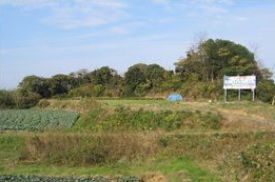
These tombs of the Munakata clan were constructed during the fifth century. Katsuura Minenohata Tomb is a huge 100-meter-long keyhole-shaped tomb, from which a bronze mirror similar to those discovered at Okinoshima ritual sites was unearthed.
Ten-minute walk from Higashi bus stop
Araji Exhibition Hall
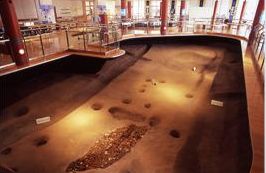
The site of this medieval foreign settlement is preserved at Tsuyazaki Elementary School, since the site was excavated on school property. Reservations to Fukutsu City Board of Education are necessary to visit the exhibition hall.
※お問い合わせ:福津市文化財課(下記参照)
One-minute walk from Tsuyazaki Shogakko-mae bus stop
Miyajidake Shrine
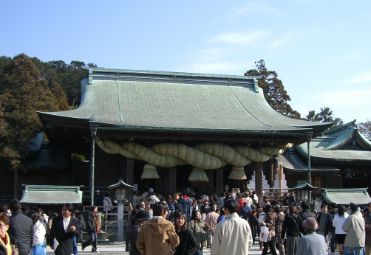
This shrine is well known for its sacred rope, bell, and drum, which are the largest in Japan. In its precincts, there is an ancient mounded tomb of round shape measuring 35 meters in diameter. The tomb has a 23-meter-long stone chamber, which is the second longest in Japan.
One-minute walk from Miyajidake Jinja Mae bus stop
Fukutsu City Office for World Heritage
| Fukutsu City Office for Cultural Property |
|
|---|


